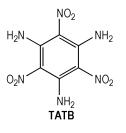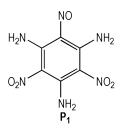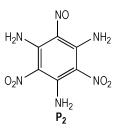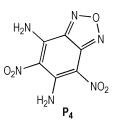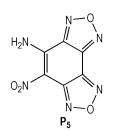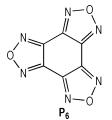2. 中国工程物理研究院化工材料研究所, 四川 绵阳 621999;
3. 北京大学化学与分子工程学院放射化学与辐射化学重点学科实验室, 北京分子科学国家实验室, 北京 100871
2. Institute of Chemical Materials, China Academy of Engineering Physics, Mianyang 621999, China;
3. Beijing National Laboratory for Molecular Sciences, Radiochemistry and Radiation Chemistry Key Laboratory of Fundamental Science, Department of Applied Chemistry, College of Chemistry and Molecular Engineering, Peking University, Beijing 100871, China
1, 3, 5-三氨基-2, 4, 6-三硝基苯(TATB)是一种性能优异的单质钝感含能材料,因其熔点高、耐热性能好、具非线性光学特性等[1-3],是美国能源部唯一通过十一项安全鉴定的钝感高能单质炸药,在各种尖端和常规武器领域中有着重要的应用[4-6]。
当武器处于外太空、核环境等特殊辐射环境中,炸药的物理化学性质会发生改变,因此有必要对炸药的辐射稳定性进行评估[7-9]。20世纪40年代末,美国洛斯阿拉莫斯国家实验室(LANL)和橡树岭国家实验室(ORNL)的J R Holdon等[10]首次研究了γ射线对炸药的影响,结果表明γ射线辐照对1, 3, 5-三硝基-1, 3, 5-三氮环已烷、三硝基甲苯、2, 4, 6-三硝基苯硝胺等炸药无明显影响,试样放出的气体量极少,熔点的变化可忽略不计。美国圣地亚实验室(SNL)[11]研究发现TATB基钝感高能炸药辐照后颜色发生明显变化,由黄色渐变为深绿色。Skidmore等[11]同样发现被辐照的TATB都呈现一定程度的颜色变化,且变色程度与剂量正相关。Giefers等[12-13]通过同步辐射对TATB的辐射降解开展了较多的研究,TATB在正常状态下降解缓慢,辐照对炸药性能影响不大。当样品受到紫外光照射时,TATB颜色也会发生变化[14-15]。
目前,TATB辐照后的颜色变化机理一直未有明确结论。由于TATB分子内部和分子间都存在非常强的氢键[16],在传统有机溶剂中的溶解度非常小,TATB在其良溶剂二甲基亚砜(DMSO)[17-18]中的溶解度也仅约70 mg·L-1[19]。但是,近年研究人员发现离子液体能够溶解具有强氢键作用的体系[19]。Pagoria等[20]发现1-乙基-3-甲基咪唑乙酸盐([C2mim]Ac)能在一定程度上破坏TATB的分子内氢键,提高TATB在溶剂中的溶解度。近年来,国内多家单位研究人员利用[C2mim]Ac/二甲基亚砜的混合溶剂对TATB的溶解度进行了系统研究[22-24]。因此,离子液体体系有望用于TATB辐射产物的分离研究中。
本研究以TATB辐照后的颜色变化为出发点,利用密度泛函理论对TATB的断键行为及相关产物激发态光谱进行计算。基于利用ESI-MS对有机小分子辐解机理的研究经验[25-26],以[C2mim]Ac/二甲基亚砜的混合溶剂为溶剂,通过高分辨电喷雾质谱对TATB的产物进行研究,推测了TATB辐照变色的机制。
2 实验部分 2.1 试剂1, 3, 5-三氨基-2, 4, 6-三硝基苯(TATB),纯度>98%,中国工程物理研究院化工研究所; 1-乙基-3-甲基咪唑乙酸盐([C2mim]Ac),纯度>98%,中国科学院兰州化学物理研究所; 二甲基亚砜(DMSO),纯度>98%,北京试剂公司。
2.2 理论计算本研究中所有结构的优化及热力学参数的计算均通过Gaussian 09[27]在B3LYP/6-311+G(d, p)水平上完成,激发态的计算通过Gaussian 09在OLYP/6-311+G(d, p)水平上完成。获取TATB在298.15 K条件下的结构、焓(H)、熵(S)、Gibbs自由能(G)和内能(U)等参数。
2.3 样品辐照用电子天平称取0.1 g TATB置于清洁干燥的辐照管内,用锡箔纸封口并编号,随后送至60Co-γ源辐照室中辐照(北京大学化学学院应用化学系)辐照,剂量率ca. 220 Gy·min-1下辐照1000 kGy。剂量率的测定由Frick剂量计进行标定。
2.4 高分辨电喷雾质谱(High-resolution ESI-MS)将辐照的TATB溶解在[C2mim]Ac中,然后取少量TATB/[C2mim]Ac溶于DMSO中,通过配备了电喷雾电离源的傅里叶变换离子回旋共振质谱仪(Solarix XR,Bruker,德国)进行分析。检测模式为负离子模式,检测范围(m/z): 100~2000,氮气作为雾化和干燥气。
3 结果与讨论 3.1 TATB辐解路径的热力学参数计算根据光子与有机小分子的作用机制,当γ光子与有机小分子相互作用时,有机小分子吸收γ光子能量导致化学键断裂,生成激发态分子、电子和自由基,进而引发后续的化学键断裂反应。因此,从TATB的化学结构出发,首先研究了TATB在辐照过程中各种化学键发生断键的可能性,并给出了相应断键过程中的热力学参数,详细结果见表 1和图 1。由表 1可以看出,在真空条件下,TATB分子发生断键形成自由基是非热力学自发过程,需要额外的能量才能促使断键的发生。通过比较可知,辐照过程中产生自由基的难易程度依次为: ·NO2(ΔGg=218.4 kJ·mol-1) > ·O (ΔGg= 377.0 kJ·mol-1)> ·NH2(ΔGg=385.3 kJ·mol-1) > ·H(ΔGg=412.3 kJ·mol-1),因此可知,辐照过程中产生·NO2、·O、·NH2等自由基的概率较大,其中产生·NO2的概率最大。
| 表 1 TATB辐解路径的热力学参数(298.15 K, 气相) Tab.1 Thermodynamic parameters for radiolysis route of TATB (298.15 K, gas) |
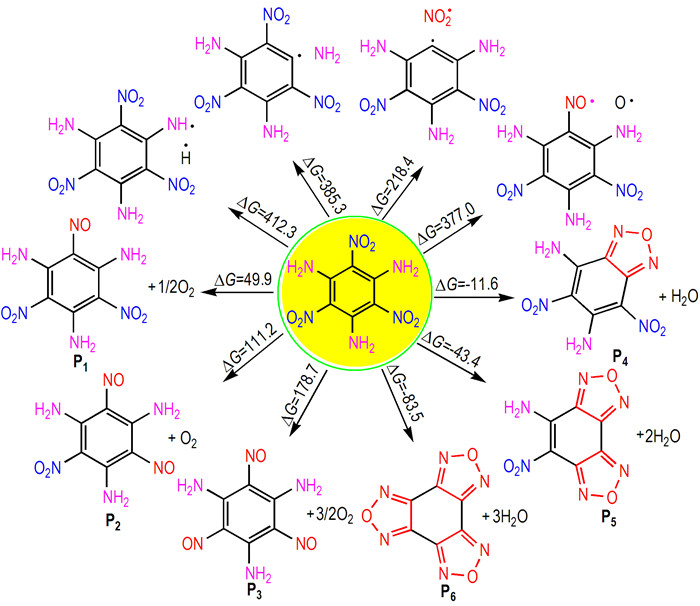
|
图 1 TATB可能的辐解方式 Fig.1 Possible radiolysis route of TATB |
基于TATB可能断键方式,以及相关文献[26]推测,TATB辐照过程产生的有色产物可能为含有亚硝基(P1,P2和P3)、苯并呋咱结构(P4,P5和P6)的产物(见图 1)。因此,对优化后的TATB及辐解产物的热力学参数进行分析,将计算所得的热力学能变(ΔUg)、焓变(ΔHg)、Gibbs自由能变(ΔGg)和熵变(ΔSg)见表 1,该热力学值反映了TATB可能的辐解路径。由表 1可知,由TATB辐解产生含有亚硝基的产物是非热力学自发过程,随着亚硝基结构的增多,Gibbs自由能增加,表明该产物越难形成。相反,由TATB辐解生成含有苯并呋咱结构的产物是热力学自发过程,表明该产物可能在辐照过程中产生。
3.2 TATB辐解产物激发态的计算含时密度泛函理论(TDDFT)在激发态性质和电子光谱计算中已经被广泛应用[29-32], 对于TATB的计算可以给出精确的数据。因此, 对TATB可能的辐解产物进行了TDDFT激发态性质和电子光谱的计算。由于TATB的辐照未在溶剂中进行, 因此模拟计算过程中仅计算了真空条件下的结果。
表 2和图 2为TATB激发态计算的结果, 在300~400 nm范围内观察到振子强度(oscillator strength)较大的吸收峰。通过对TATB的前线轨道进行分析, 如图 3, 其中325.68 nm处对应TATB的分子轨道(MO)π→σ*跃迁, 400.02 nm处对应TATB的分子轨道π→π*跃迁。该计算结果与文献报道实验值的360 nm和430 nm[33-34]有一定偏差, 这是由于该计算仅考虑了TATB在单分子状态下激发。对TATB的π→π*跃迁进行分析, 其振子强度为0.0014, 由MO=65跃迁至MO=67贡献了47.3%, 由MO=66跃迁至MO=67贡献了16.2%。
| 表 2 基于TDDFT方法获得的TATB相关产物紫外光谱数据 Tab.2 Calculated data of TATB related products based on TDDFT method (298.15 K, gas) |
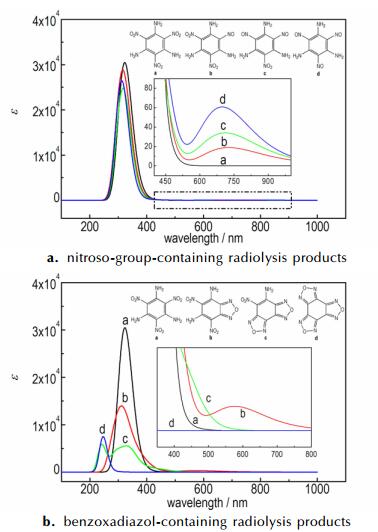
|
图 2 TDDFT计算方法获得TATB相关产物的紫外光谱 Fig.2 Calculated UV-vis spectra of TATB related products by TDDFT method |
基于此, 对含有亚硝基(P1, P2和P3)、苯并呋咱结构(P4, P5和P6)的产物进行了计算和分析(图 3)。TATB辐解生成具有一个亚硝基结构的产物P1时, 在600~800 nm内出现了新的吸收峰, 即, 峰位置699.91 nm, 对应振子强度为0.0003, 该吸收峰的形成会导致其颜色变为绿色。通过对P1的前线轨道进行分析, 699.91 nm处的吸收峰归属于P1的π*→σ*跃迁, 其中由MO=62跃迁至MO=63贡献了21.6%, 由MO=62跃迁至MO=64贡献了60.9%。进一步分析发现, 随着产物中亚硝基基团的增加, 700 nm附近吸收峰的强度增加, 由此推测700 nm吸收峰是由于亚硝基的形成而产生, 这与其分子轨道的分析结果一致。随后, 对含苯并呋咱结构产物的激发态光谱进行了分析。结果表明, 对于产物P4(含一个苯并呋咱结构), 在500~700 nm内新产生了一个很强的吸收峰, 即, 峰位置577.42 nm为P4的π→σ*跃迁, 与文献[32]结果接近, 对应MO=61至MO=62的跃迁吸收, 该吸收峰的形成表明P4同样会导致该产物的颜色发生变化。另外, P4的577.42 nm处吸收峰对应的振子强度(0.0072) 大大高于P1的699.91 nm处吸收峰的振子强度(0.0003), 表明P4的颜色变化比P1的颜色变化更加明显。有趣的是, 随着苯并呋咱结构的增加, P5、P6的吸收峰出现了“蓝移”现象, 即330 nm处的吸收峰向250 nm移动。由此推断, P5和P6中多个呋咱结构的形成破坏了其与苯环的共轭结构, 导致其紫外吸收“蓝移”。产物P5和P6在500~700 nm内未出现新的吸收峰, 因此排除其导致TATB辐照致变色的可能性。

|
图 3 TATB相关产物激发态跃迁轨道的分析 Fig.3 Assignment of molecular orbits of TATB related products |
通过高分辨ESI-MS(负离子模式)对辐照前后的TATB样品进行分析, 如图 4与表 3所示。对于未辐照的样品, 在229.119, 357.177, 371.193, 385.209, 399.224, 513.267, 555.314, 569.330等处检测到了[C2mim]Ac相关离子及其离子簇的信号。在257.027, 615.996, 666.020, 1033.991等处检测到了TATB相关离子及其离子簇的信号, 分别对应[C6H5N6O6]-(理论值: 257.028), [2C6H6N6O6+CrO3]-(理论值: 615.996)、[2C6H6N6O6+NH2OH+HCrO4]-(理论值: 666.020)、[3C6H6N6O6+Cr2O6+CO(NH2)2]-(理论值: 1033.988)。
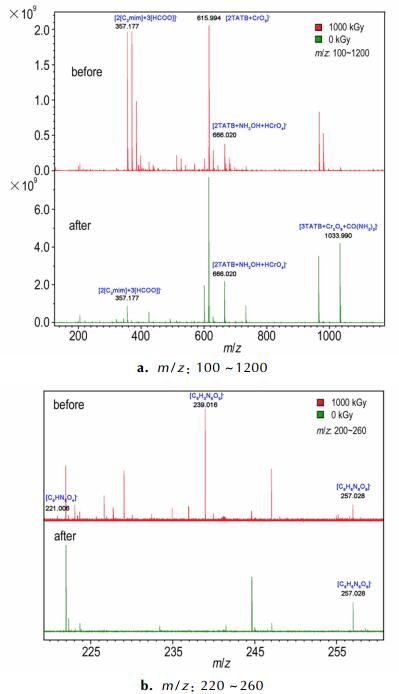
|
图 4 TATB辐照前后的高分辨电喷雾质谱图 Fig.4 High-resolution ESI-MS spectra of TATB before and after irradiation |
| 表 3 TATB辐照后各信号的归属 Tab.3 Designation of radiolytic products of TATB after γ-irradiation |
图 4为TATB辐照前后的高分辨电喷雾质谱图, 表 3为TATB辐照后各信号的归属。从图 4和表 3可以看出, 在239.016处出现了新的辐解产物峰, 对应的分子式为[C6H3N6O5]-(理论值: 239.017)。同时, 在221.006处出现了信号微弱的辐解产物峰, 对应的分子式为[C6H1N6O4]-(理论值: 221.006)。通过对产物结构的分析, [C6H3N6O5]-为含苯并呋咱结构的P4, [C6H1N6O4]-对应为含苯并双呋咱结构的P5, 其他信号的分析中未发现含亚硝基的辐解产物。由此推断, TATB在辐照过程中, 主要形成含苯并呋咱结构的产物(P4), 此外, 还会产生极少量的含苯并双呋咱结构的产物(P5), 其中含苯并呋咱结构的产物(P4)会导致TATB的颜色发生变化。
4 结论(1) TATB在辐照过程中产生·NO2、·O、·NH2等自由基的概率较大, 主要辐解产物含有亚硝基、苯并呋咱结构。
(2) 利用[C2mim]Ac/二甲基亚砜的混合溶剂作为溶剂, 通过高分辨电喷雾质谱首次确认了TATB的主要辐解产物为苯并呋咱结构化合物。
(3) TATB辐解生成的苯并呋咱结构的产物会在600~700 nm内产生新的吸收峰, 这会导致TATB的颜色由黄色变为绿色。
| [1] | VoigtMartin I G, Li G, Yakimanski A, et al. The origin of nonlinear optical activity of 1, 3, 5-triamino-2, 4, 6-trinitrobenzene in the solid state: The crystal structure of a non-centrosymmetric polymorph as determined by electron diffraction[J]. Journal of the American Chemical Society, 1996, 118(50): 12830-12831. DOI:10.1021/ja9611708 |
| [2] | Brill T B, James K J. Kinetics and mechanisms of thermal-decomposition of nitroaromatic explosives[J]. Chemical Reviews, 1993, 93(8): 2667-2692. DOI:10.1021/cr00024a005 |
| [3] | Zyss J, Ledoux I. Nonlinear optics in multipolar media-theory and experiments[J]. Chemical Reviews, 1994, 94(1): 77-105. DOI:10.1021/cr00025a003 |
| [4] |
董海山, 周芬芬.
高能炸药及相关物性能[M]. 北京: 科学出版社, 1989.
DONGH Hai-shan, ZHOU Fen-fen. High energy explosives and correlative physical properties[M]. Beijing: Science Press, 1989. |
| [5] |
孙国祥.
高分子混合炸药[M]. 北京: 国防工业出版社, 1984.
SUN Guo-xiang. Polymer blended explosives[M]. Beijing: National Defense Industrial Press, 1984. |
| [6] |
孙业斌, 惠君明, 曹欣茂.
军用混合炸药[M]. 北京: 兵器工业出版社, 1995.
SUN Ye-bin, HUI Jun-ming, CAO Xin-mao. Military mixed explosive[M]. Beijing: Weapon Industry Press, 1995. |
| [7] | Kaufman J. The effect of nuclear radiation on explosives[R]. In Proceedings of the Royal Society of London A: Mathematical, Physical and Engineering Sciences. 1958: 219-225. |
| [8] | Urizar M, Loughran E, Smith L. The Effects of Nuclear Radiation on Organic Explosives[M]. United States: Explosivstoffe, 1962. |
| [9] | Urbanski T, Jurecki M, Laverton S. Chemistry and technology of explosives[M]. 1964. |
| [10] | Holden J R. Literature Survey on the Effects of Neutron and Electromagnetic Irradiation on Explosives[R]. United States: Naval ordnance lab white oak, 1957. |
| [11] | Skidmore C, Idar D, Buntain G, et al. Aging and PBX 9502[R]. United States: Los Alamos National Lab, 1998. |
| [12] | Giefers H, Pravica M. Radiation-induced decomposition of PETN and TATB under extreme conditions[J]. The Journal of Physical Chemistry A, 2008, 112(15): 3352-3359. DOI:10.1021/jp710512b |
| [13] | Giefers H, Pravica M, Liermann H, et al. Radiation-induced decomposition of PETN and TATB under pressure[J]. Chemical Physics Letters, 2006, 429(1): 304-309. |
| [14] | Williams D L, Timmons J C, Woodyard J D, et al. UV-induced degradation rates of 1, 3, 5-triamino-2, 4, 6-trinitrobenzene (TATB)[J]. Journal of Physical Chemistry A, 2003, 107(44): 9491-9494. DOI:10.1021/jp027263v |
| [15] | Firsich D W, Guse M P. On the photochemical phenomenon in TATB[J]. Journal of Energetic Materials, 1984, 2(3): 205-214. DOI:10.1080/07370658408012334 |
| [16] | Cady H H, Larson A C. The crystal structure of 1, 3, 5-triamino-2, 4, 6-trinitrobenzene[J]. Acta Crystallographica, 1965, 18(3): 485-496. DOI:10.1107/S0365110X6500107X |
| [17] | Foltz M F, Maienschein J L, Green L G. Particle size control of 1, 3, 5-triamino-2, 4, 6-trinitrobenzene by recrystallization from DMSO[J]. Journal of Materials Science, 1996, 31(7): 1741-1750. DOI:10.1007/BF00372187 |
| [18] | Foltz M F, Ornellas D L, Pagoria P F, et al. Recrystallization and solubility of 1, 3, 5-triamino-2, 4, 6-trinitrobenzene in dimethyl sulfoxide[J]. Journal of Materials Science, 1996, 31(7): 1893-1901. DOI:10.1007/BF00372205 |
| [19] | ZHANG H, WU J, ZHANG J, et al. 1-Allyl-3-methylimidazolium chloride room temperature ionic liquid: A new and powerful nonderivatizing solvent for cellulose[J]. Macromolecules, 2005, 38(20): 8272-8277. DOI:10.1021/ma0505676 |
| [20] | Pagoria P F, Maiti A, Gash A, et al. Ionic liquids as solvents[P]. 2009. |
| [21] |
齐秀芳, 李天涛, 程广斌, 等. TATB在离子液体-DMSO复合溶剂体系中的溶解性实验研究[J].
化学试剂, 2013(3): 249-251. QI Xiu-fang, LI Tian-tao, CHENG Guang-bin, et al. Solvation of TATB in ionic liquid-DMSO combined solvents[J]. Huaxue Shiji, 2013(3): 249-251. |
| [22] |
曹雄, 罗帅, 许丽娟, 等. TATB的热分解及其在[Emim]Ac/DMSO溶剂中的热爆炸特性[J].
火炸药学报, 2016(1): 52-55. CAO Xiong, LUO Shuai, XU Li-juan, et al. Thermal decomposition of tatb and its thermal explosion characteristics in[Emim]Ac/DMSO solvent[J]. Chinese Journal Explosives & Propellants, 2016(1): 52-55. |
| [23] |
朱海翔, 李金山, 徐容, 等. TATB在1-乙基-3-甲基咪唑醋酸盐/二甲亚砜混合溶剂中的溶解度及结晶[J].
火炸药学报, 2012, 35(2): 19-22. ZHU Hai-xiang, LI Jin-shan, XU Rong, et al. Solubility and crystallization of TATB in the mixed solvent of 1-ethyl-3-methylimidazolium acetate/dimethyl sulfoxide[J]. Chinese Journal Explosives & Propellants, 2012, 35(2): 19-22. |
| [24] | AO Y Y, PENG J, YUAN L Y, et al. Identification of radiolytic products of[C4mim][NTf2] and their effects on the Sr2+ extraction[J]. Dalton Transactions, 2013, 42(12): 4299-4305. DOI:10.1039/c2dt32418k |
| [25] | AO Y Y, YUAN W J, YU T L, et al. Radiolysis of crown ether-ionic liquid systems: identification of radiolytic products and their effect on the removal of Sr2+ from nitric acid[J]. Physical Chemistry Chemical Physics, 2015, 17(5): 3457-3462. DOI:10.1039/C4CP04294H |
| [27] | Frisch M J, Trucks G W, Schlegel H B, et al. Gaussian 09(Revision A.02[CP]. Gaussian, Inc, Wallingford, CT, 2009. |
| [26] | McDonald J W, Schenkel T, Newman M W, et al. The effects of radiation on (1, 3, 5-triamino-2, 4, 6-trinitrobenzene) TATB studied by time-of-flight secondary ion mass spectrometry[J]. Journal of Energetic Materials, 2001, 19(2-3): 101-118. |
| [27] | Robinson D. Accurate excited state geometries within reduced subspace TDDFT/TDA[J]. Journal of Chemical Theory and Computation, 2014, 10(12): 5346-5352. DOI:10.1021/ct500687j |
| [28] | Peach M J G, Williamson M J, Tozer D J. Influence of Triplet Instabilities in TDDFT[J]. Journal of Chemical Theory and Computation, 2011, 7(11): 3578-3585. DOI:10.1021/ct200651r |
| [29] | Brabec J, Lin L, Shao M Y, et al. Efficient algorithms for estimating the absorption spectrum within linear response TDDFT[J]. Journal of Chemical Theory and Computation, 2015, 11(11): 5197-5208. DOI:10.1021/acs.jctc.5b00887 |
| [30] | Baseggio O, De Vetta M, Fronzoni G, et al. Photoabsorption of icosahedral noble metal clusters: an efficient TDDFT approach to large-scale systems[J]. Journal of Physical Chemistry C, 2016, 120(23): 12773-12782. DOI:10.1021/acs.jpcc.6b04709 |
| [31] |
陈云阁, 刘英, 王晶禹, 等. 紫外光谱法应用于TATB基炸药中TATB含量的测量[J].
火工品, 2014(6): 47-50. CHEN Yun-ge, LIU Ying, WANG Jing-yu, et al. The application of UV spectrophotometry method to analyze the contents of TATB in PBX explosives[J]. Initiators & Pyrotechnics, 2014(6): 47-50. |
| [32] | XIONG Y, LIU J, ZHONG F C, et al. Identification of the free radical produced in the photolysis of 1, 3, 5-triamino-2, 4, 6-trinitrobenzene(TATB)[J]. Journal of Physical Chemistry A, 2014, 118(34): 6858-6863. DOI:10.1021/jp5029867 |

The thermodynamic parameters and the excited states ofradiolysis products of 1,3,5-triamino-2,4,6-trinitrobenzene(TATB) were obtained by density functional theory calculation(DFT). The gamma-ray radiolysis products of TATB were studied by high-resolution electrospray ionization mass spectrometry(ESI-MS).





